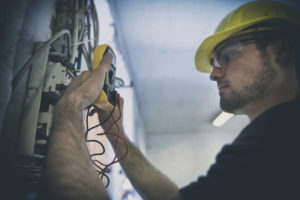7 Safety Tips for Electrical Energy Hazards
 As an electrician, it is important to reduce the risk of electrical energy hazards. Whether you are trained in safety protocols or need to wear protective gear, you can stay safe on the worksite. In this guide, we offer 7 safety tips for reducing the risk of electrical energy hazards. But, first, let’s look at what some of the electrical energy hazards are and how to minimize their risk.
As an electrician, it is important to reduce the risk of electrical energy hazards. Whether you are trained in safety protocols or need to wear protective gear, you can stay safe on the worksite. In this guide, we offer 7 safety tips for reducing the risk of electrical energy hazards. But, first, let’s look at what some of the electrical energy hazards are and how to minimize their risk.
What are Electrical Energy Hazards?
When performing projects, electricians will come in contact with electrical energy. It is important to reduce the risk of electrical energy hazards. Some of these hazards include:
Arc Flashes
An arc flash occurs when a flashover of electric current leaves its intended path and travels through the air from one conductor to another, or to the ground, according to OSHA. Arc flashes can cause serious injury. Arc flashes are commonly caused by dust, dropping tools, an accidental touch, condensation, material failure, corrosion, and faulty installation.
Electric Shock
Electric shock can occur when an electrician comes in contact with live electrical parts. Without the proper protective gear, like rubber gloves, the electrician can be exposed to severe electrical shock. Safety protocols call for electricians to power down electrical components when applicable. Implementing a checklist assists safety protocols that include checking for damaged plugs or connectors, whether cables are repaired with tape or not secure, or if burn marks are present. These are all indicators that a tool may be damaged and could cause electric shock.
Contact Burns
Contact burns can occur when an electrician comes in contact with faulty electrical equipment or is exposed to flash arcs. Safety protocols call for fire-proof jackets and overalls, as well as rubber gloves, eye protection and other preventative measures to reduce electrical energy hazards. Proper workwear will also prevent clothing from burning to an electrician’s skin.
Explosions
Static electricity igniting flammable vapors or dusts can cause explosions. These electrical energy hazards can also be caused by using an unsuitable electrical apparatus.
7 Safety Tips for Electrical Energy Hazards
As an electrician, it is important to adhere to safety protocols. Here are a few safety tips to minimize the risk of electrical energy hazards.
Tip #1: Get Fully Trained
A great way to stay safe with electrical energy hazards is getting fully trained by industry professionals. Ohio Business College (OBC) offers an Electrician program that can be completed in as little as 9 months. You will get classroom theory and hands-on training in both residential and commercial electrical. You will also receive safety training to keep you safe from electrical energy hazards.
Tip #2: Wear Protective Gear
Electricians can wear safety clothing to stay safe from arc flashes and electric shock. Electricians will want to wear protective gear to safeguard them from electrical energy hazards. This protective equipment includes:
Arc Flash PPE Suits & Blankets – arc flashes can be caused by dust, dropping a tool, condensation, and corrosion. Electricians can lessen the risk of exposure by wearing proper electrical contractor safety clothing.
Rubber Voltage Gloves – it is important to wear proper gloves when fixing electrical components. Electrical insulated rubber gloves help protect electricians from arc flash hazards and electrical shock. These gloves can consist of leather protectors to prevent cuts, punctures, and abrasions.
Insulated Electrical Tools – the use of hand tools near energized equipment can cause electrical energy hazards. Insulated electrical tools are fully compliant and tested to work with live electrical equipment to eliminate electrical energy hazards.
High Visibility Workwear – electricians should wear high visibility workwear so they are seen by forklift, crane, and other motorized equipment operators. Some high visibility workwear comes in yellow or orange and includes reflective tape to protect electricians working at night.
Tip #3: Never Use Damaged Equipment or Tools
Before using any electrical tools or equipment, it is important to fully inspect them to make sure they are safe and reliable. Check for burn marks, exposed wires, repairs with tape or other signs that an electrical tool may be damaged. Replace damaged equipment and report any injuries to a supervisor.
Tip #4: Use GFCIs With Temporary Electricity or In Wet Locations
Ground Fault Circuit Interrupters (GFCIs) help guard electricians from electrical shock. Unlike a normal outlet, a GFCI outlet will have a test and reset button on the outlet face. GFCIs reduce the risk of electrical fire and prevent serious electric shock by monitoring electrical current, cutting power when an imbalance of electricity is present.
Tip #5: Treat All Wires as If They are Energized.
When working on electrical components, it is important to always act as if the wires are electrified. Take proper safety precautions, use your checklist to identify any electrical energy hazards, and wear protective clothing to minimize exposure.
Tip #6: Ensure all Tools and Wiring are Properly Grounded
A grounded system uses non-current-carrying conductive material that encloses electrical conductors, and is connected to the earth to limit the voltage to ground on materials, according to the National Electrical Code (NEC), NFPA 70®, Section 250.4(A)(2). An effective ground-fault current path can be created through the equipment grounding conductor (EGC). EGCs use non-conductive materials like cooper, aluminum, rigid metal conduit, intermediate medial conduit, and electrical metallic tubing.
Tip #7: Follow the National Electrical Code (NEC)
The National Electrical Code, also known as the NFPA 70, is a US standard for safe installation of electrical wiring and equipment. It is part of the National Fire Protection Associations (NFPA) guidelines. The NEC codifies the requirements for safe electrical installation, according to the Electrical Safety Foundation International (ESFI).
How Do You Become an Electrician?
A great way to become an electrician and learn about all the safety precautions needed to reduce the risk of electrical energy hazards is by attending an Electrician program at Ohio Business College. OBC offers full-time classes that can be completed in as little as 9-months. This program prepares you for entry-level positions as an apprentice electrician.
Our 48-credit hour Electrician program includes courses on wiring, cabling and connections, motors and controls, low voltage, as well as both residential and commercial installation. OBC keeps class sizes small that allow instructors to give personal attention to students. We also offer a flexible learning environment for adults with other commitments. Let Ohio Business College prepare you to become an electrician and keep you safe from electrical energy hazards in the process.
Want to Learn More?
At Ohio Business College, you can enroll in an Electrical Technician Diploma Program that can prepare you for an entry-level position as an electrical technician, providing skills and services that are needed in a variety of settings, including residential, commercial and industrial. Whether it’s wiring a new building, fixing an electrical problem, or getting old wiring up to code, Ohio Business College can get you the hands-on training you need to become employed in this vital field.
Contact us today to learn more about our Electrical technician programs.

